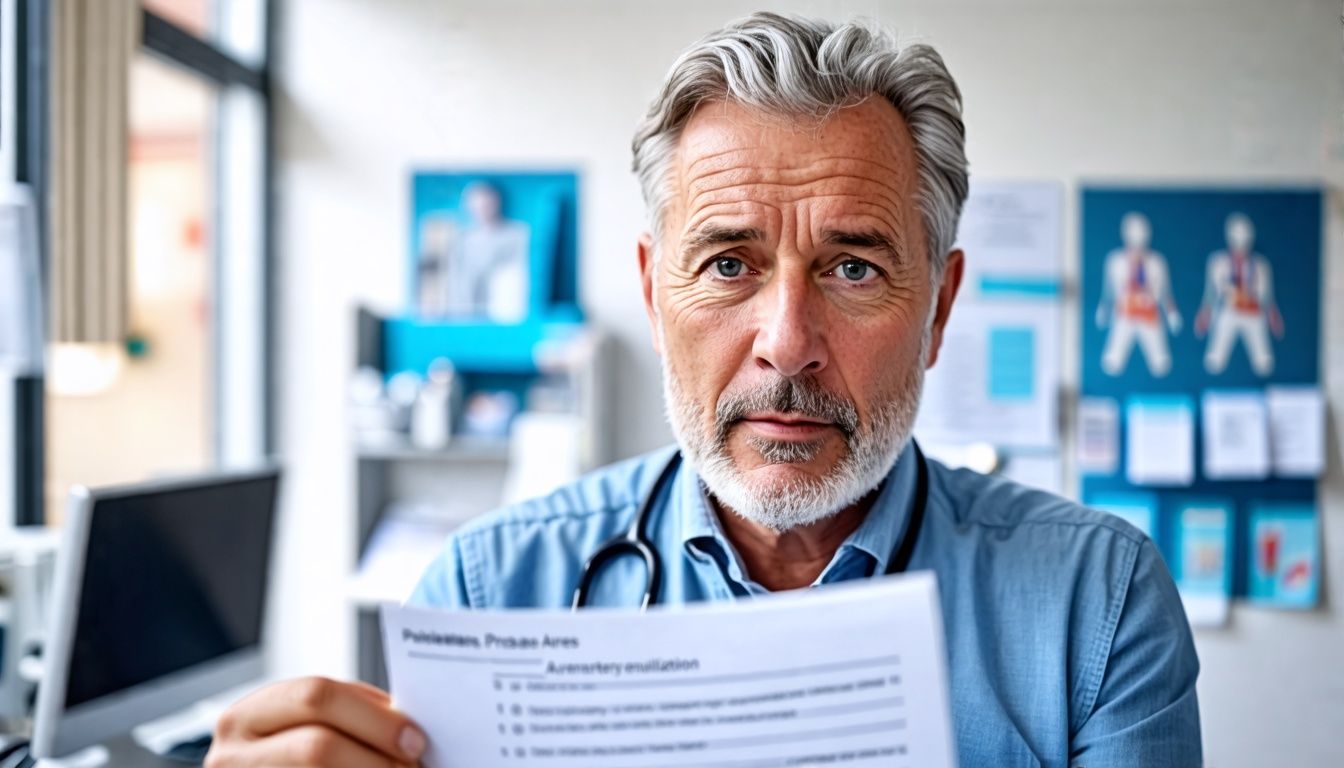After a prostate biopsy, it’s natural to wonder how soon you can resume exercising and what precautions you should take. Understanding the timeline for exercise after a prostate biopsy is essential for a safe and gradual return to physical activity. Here, we’ll provide you with the necessary information and tips to help you navigate this recovery period effectively.
Key Takeaways:
- Recovery from a prostate biopsy usually takes a few days.
- Avoid any exercise or strenuous activity for up to 5 days after the procedure.
- Take prescribed antibiotics to prevent infections.
- Follow recommended guidelines to exercise safely and minimize the recovery period.
- Consult your doctor for personalized advice on when to resume physical activity after a prostate biopsy.
Understanding the Prostate Biopsy Procedure
During a prostate biopsy, a surgeon removes tissue samples from the prostate gland for analysis to determine the presence of cancer cells. The procedure involves the following steps:
1. Preparation:
Prior to the biopsy, you may be asked to temporarily discontinue blood thinners and antibiotics to reduce the risk of bleeding or infection. You will also be given instructions to clean your rectum using an enema.
2. Anesthesia:
The procedure is usually performed under local anesthesia to minimize discomfort. In some cases, general anesthesia may be used.
3. Types of Prostate Biopsies:
There are three types of prostate biopsies:
- Transrectal Biopsy: This is the most common type of biopsy. The surgeon inserts a thin needle through the wall of the rectum to collect tissue samples from various areas of the prostate.
- Transperineal Biopsy: In this approach, the surgeon inserts a needle through the perineum (the area between the scrotum and anus) to collect tissue samples.
- Transurethral Biopsy: This type of biopsy is typically performed during a cystoscopy. The surgeon inserts a cystoscope through the urethra to access the prostate and collect tissue samples.
4. Guided Needle Insertion:
During the biopsy, the surgeon uses ultrasound or a scope to guide the biopsy needle to the targeted areas of the prostate. Multiple tissue samples are collected to increase the accuracy of the biopsy.
5. Side Effects:
After the biopsy, you may experience some side effects, including:
- Bleeding in the rectum, semen, urine, or stool
- Temporary difficulty urinating
Understanding the prostate biopsy procedure is vital in comprehending how tissue samples are collected for analysis. The different types of biopsies and the potential side effects should be taken into consideration when undergoing this diagnostic procedure.
Recovery Period and Restrictions
After a prostate biopsy, it is crucial to allow your body sufficient time to heal and recover. The typical recovery time after a prostate biopsy is a few days, although it may vary depending on individual circumstances. During this period, it is essential to adhere to certain restrictions and guidelines to promote healing and minimize the risk of complications.
Here are some important considerations:
- Avoid strenuous activity: Engaging in rigorous exercise or heavy lifting can put strain on the body and potentially disrupt the healing process. It is advisable to refrain from strenuous activity for the first few days after the procedure.
- Exercise restrictions: While it is important to stay active for overall health, it is recommended to avoid rigorous exercises such as heavy weightlifting or high-impact activities for a week or as advised by your healthcare provider. Opt for light exercises, such as walking or gentle stretching, during the recovery period.
- Bowel movement precautions: Straining during bowel movements can potentially cause discomfort and disrupt the healing process. To avoid unnecessary strain, ensure your diet includes an adequate amount of fiber and drink plenty of water to promote smooth bowel movements.
- Sexual activity and masturbation: Refraining from sexual activity or masturbation for the first 48 hours after a prostate biopsy can help prevent irritation and minimize the risk of infection. It is important to follow your healthcare provider’s instructions regarding this aspect of recovery.
By following these guidelines and restrictions, you can give your body the time it needs to recover properly after a prostate biopsy. Remember to consult with your healthcare provider for personalized advice based on your specific circumstances.

Prostate Biopsy Recovery Guidelines:
| Recovery Recommendations | Benefits |
|---|---|
| Avoid strenuous activity | Minimizes the risk of complications and promotes healing |
| Exercise restrictions | Ensures a gradual return to physical activity |
| Bowel movement precautions | Prevents strain and discomfort |
| Sexual activity and masturbation guidelines | Reduces the risk of irritation and infection |
Sexual Activity and Prostate Biopsy
After a prostate biopsy, it is important to allow the affected area to heal before engaging in sexual activity or masturbation. This gives the body time to recover and reduces the risk of complications or discomfort.
Precautions for sexual activity after a prostate biopsy:
- Wait a few days before resuming sexual activity or masturbation to allow for proper healing.
- Wearing condoms during this period can help prevent irritation and protect the areas around the rectum, perineum, and urethra.
Changes in semen after a prostate biopsy:
It is normal to experience slight reddish or dark discoloration of semen for a few weeks after the biopsy. This happens because blood can mix with the semen during ejaculation. These changes are temporary and should resolve over time.
To illustrate, here is an image that shows the relevant details:

By following these precautions and understanding the changes in semen, you can safely resume sexual activity after a prostate biopsy. If you have any concerns or questions, it is always best to consult with your doctor for personalized advice and guidance.
Conclusion
A prostate biopsy is a quick and relatively low-risk procedure that offers high accuracy in detecting prostate cancer. Although there might be some limitations, such as the possibility of missed cases or false negatives, advancements in techniques like MRI and urine tests show promise in improving accuracy.
To minimize recovery time after a prostate biopsy, it is important to follow certain guidelines. Stopping blood thinners, taking prescribed antibiotics, using enemas as instructed, resting, reducing stress, staying hydrated, and avoiding caffeine and alcohol can all contribute to a quicker recovery.
Additionally, there are alternatives to a prostate biopsy that can be considered, such as the digital rectal exam, prostate-specific antigen (PSA) test, transrectal ultrasound (TRUS), urine test, and PET scan. It is crucial to discuss these options with your doctor to determine the best course of action for your specific case.
Remember, a prostate biopsy is just one step in the diagnostic process. Following up with your doctor to discuss the biopsy results and develop a comprehensive plan for the future is essential. Trust their expertise and guidance as you move forward in your prostate health journey.
FAQ
How soon can I exercise after a prostate biopsy?
It is recommended to avoid exercise or strenuous activity for up to 5 days after a prostate biopsy to reduce the risk of injury or complications.
What happens during a prostate biopsy?
During a prostate biopsy, tissue samples are taken from the prostate gland using ultrasound or a scope to guide the needle. The samples are then analyzed for the presence of cancer cells.
What are the side effects of a prostate biopsy?
Side effects may include bleeding in the rectum, semen, urine, or stool, as well as temporary difficulty urinating. Antibiotics may be prescribed to prevent infections.
How long is the recovery time after a prostate biopsy?
The recovery time after a prostate biopsy is generally a few days. It is important to follow certain restrictions and guidelines during this period to ensure proper healing.
Can I resume sexual activity after a prostate biopsy?
It is recommended to allow the affected area to heal for a few days before engaging in sexual activity or masturbation after a prostate biopsy. Precautions such as wearing condoms and protecting the areas around the rectum, perineum, and urethra should be taken.
What are the alternatives to a prostate biopsy?
Alternatives include digital rectal exam, prostate-specific antigen (PSA) test, transrectal ultrasound (TRUS), urine test, and PET scan. These tests can help screen for prostate cancer and guide further diagnosis.
How accurate are prostate biopsies in detecting cancer?
Prostate biopsies are highly accurate, but they can miss cases or provide false negatives. Newer techniques such as MRI and urine tests show promise in improving accuracy.
Should I Resume Exercise After Prostate Surgery?
After prostate surgery, resuming running after surgery should be approached cautiously. It’s crucial to follow medical advice and gradually ease back into physical activity. Listen to your body and watch for any discomfort or pain. It’s best to consult with your doctor before starting any exercise routine.



